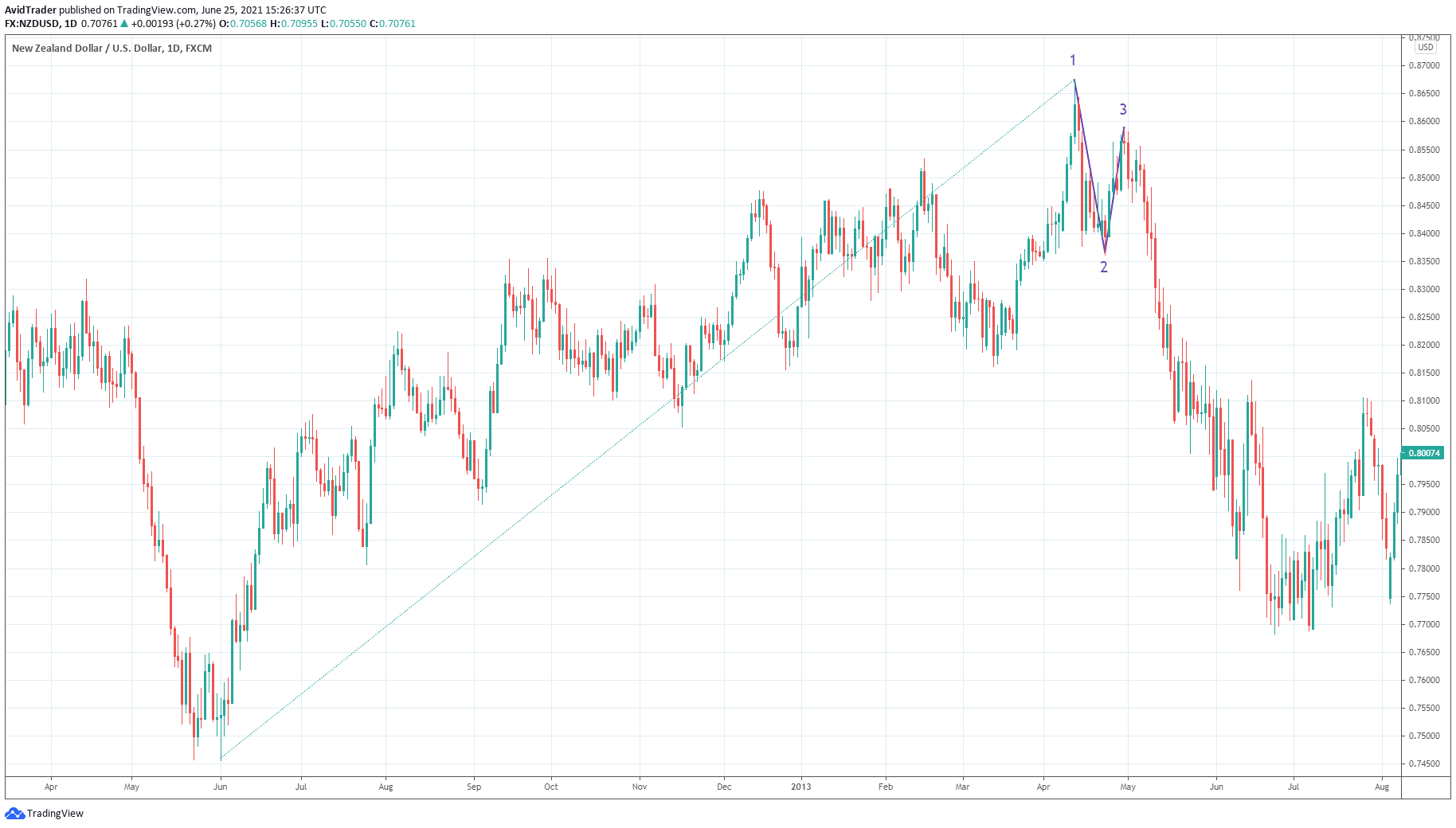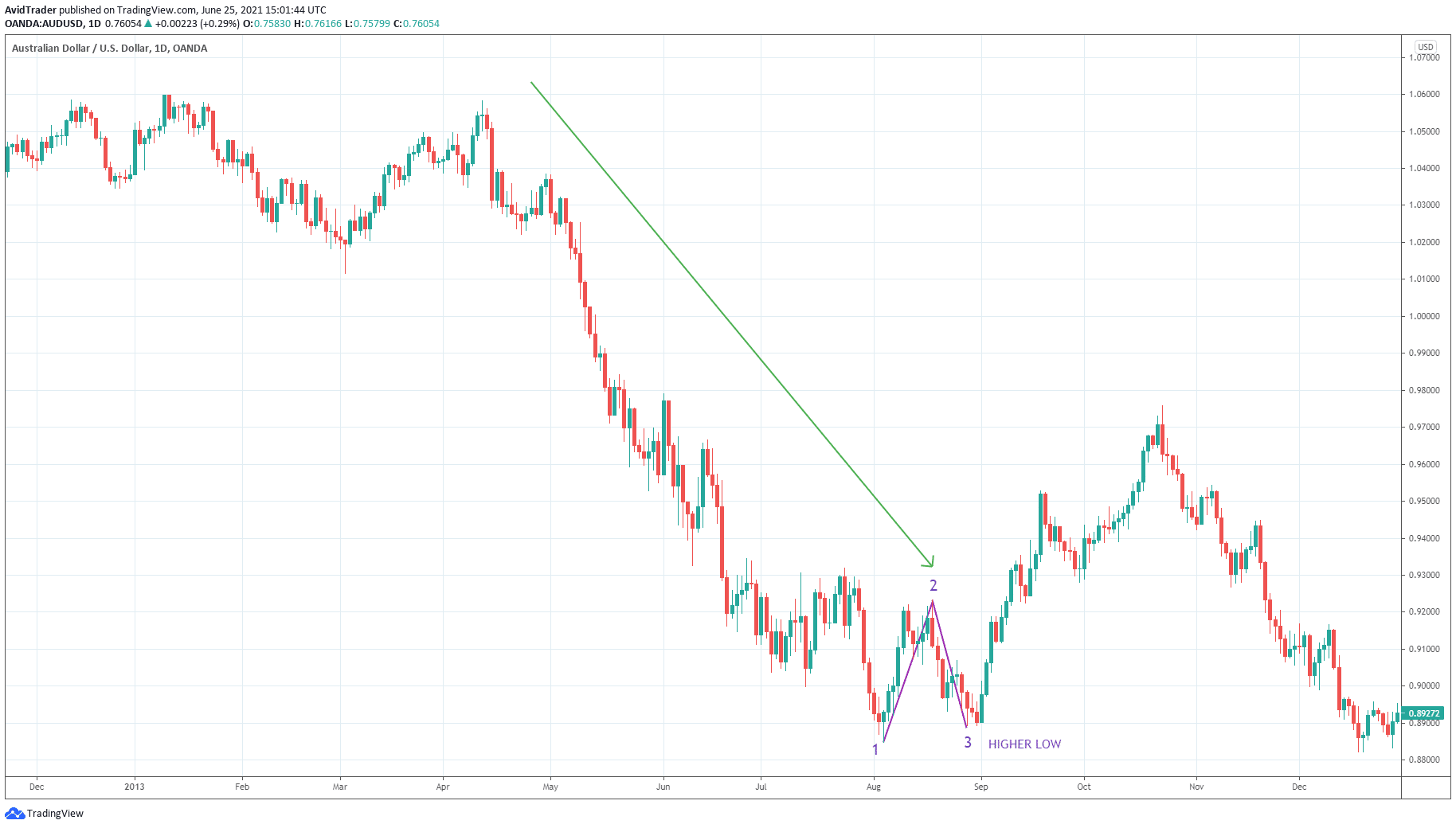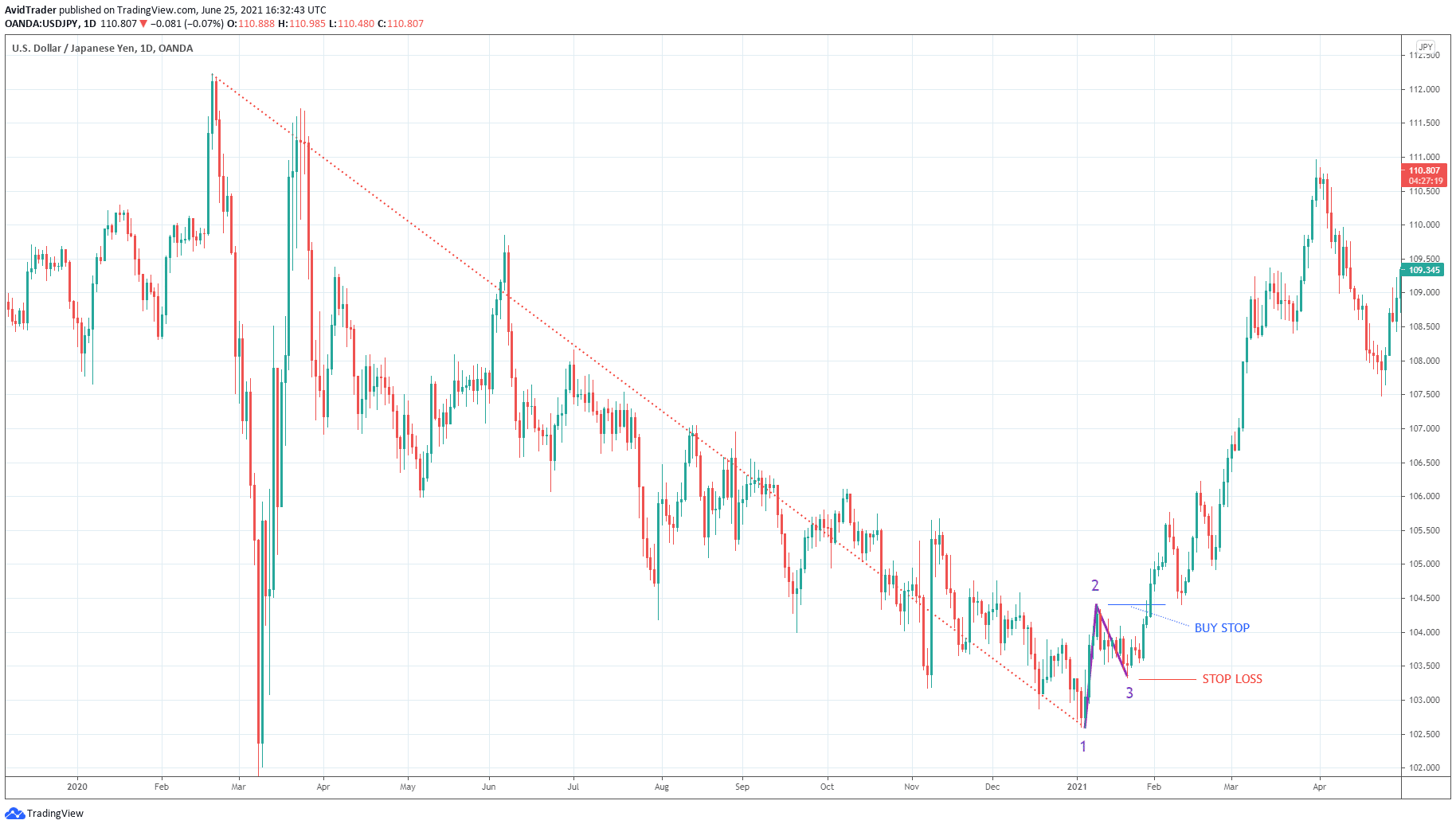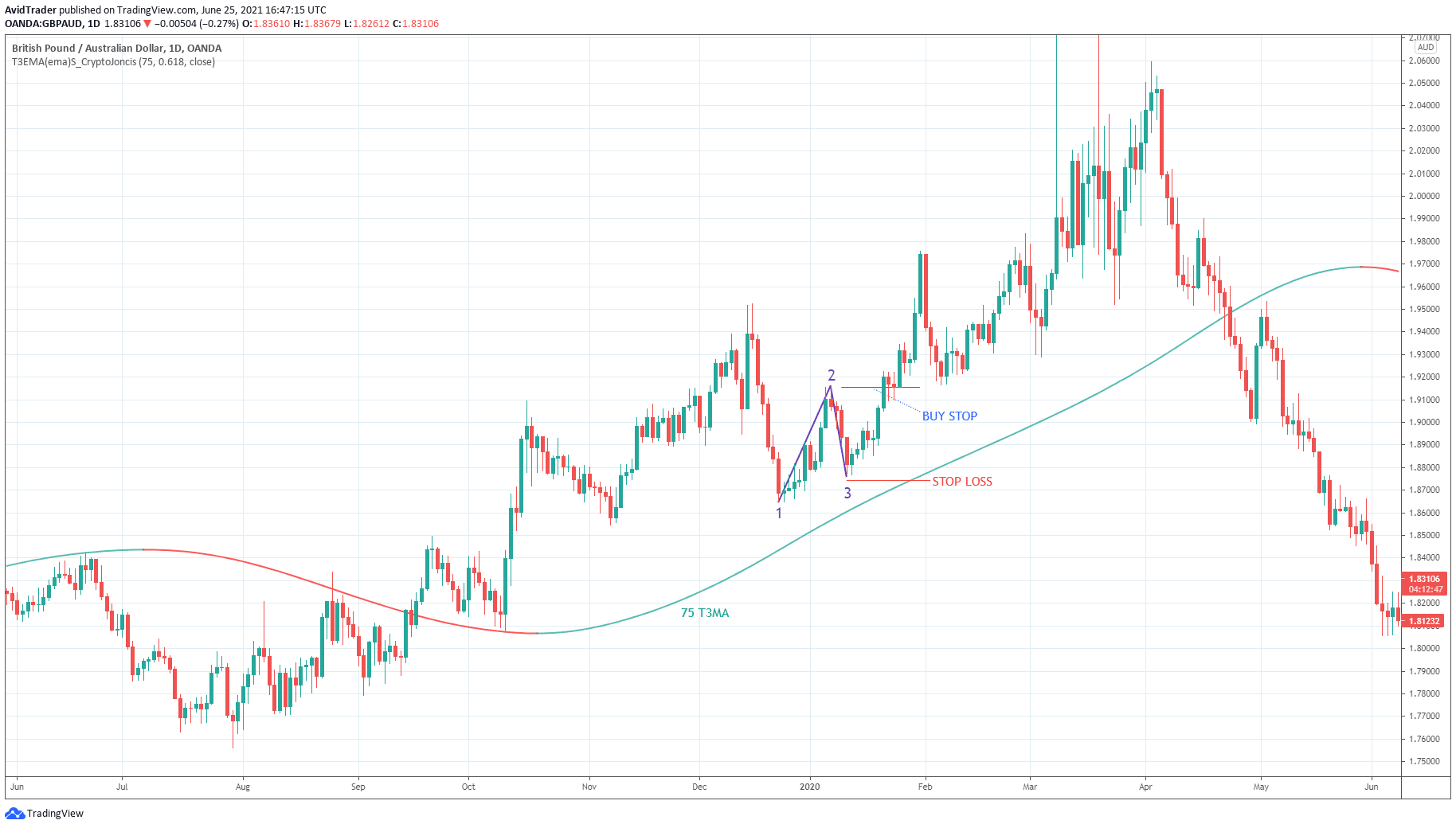The 1-2-3 pattern is probably the most straightforward standalone trading setup in existence. Furthermore, you can trade it without other technical tools such as moving average or support and resistance.
To achieve a high strike rate, make sure to qualify the setup in the manner explained in this article. Once you become familiar with this formation, you will realize that this pattern shows up very often on any time frame and symbol.
While you can trade reversals and continuations using the 1-2-3 pattern, it is better to think of the setup as a reversal pattern. Traders often use this pattern as an entry trigger of a complex system, but they call it using different names.
The 1-2-3 pattern has the following names:
- Dagger in Goodman Wave Theory
- Ross Hook in Ross Hook series
- Three-point turn in ElectroFX
Understanding the 1-2-3 pattern
In theory, a 1-2-3 pattern occurs at the end of a trend and presages the trend reversal. This is not always the case, though. Therefore, you can also use the 1-2-3 pattern to trade swings in line with the prevailing trend. As you will see later, the pattern is a price structure composed of two swings with three swing points.
However, not all price structures composed of two swings are valid 1-2-3 patterns. The structures must satisfy one criterion. When considering a potential 1-2-3 pattern, think about its size concerning the previous swing or trend. A sound 1-2-3 system is smaller in size in comparison to the preceding movement or swing.
Bearish 1-2-3 pattern
The below NZD/USD daily chart shows an example of a bearish 1-2-3 pattern. As a reversal pattern, the bearish setup forms at the end of a prolonged uptrend. Take note of the apparent long-term uptrend leading to the setup and marked by the dashed trend line.
The bearish pattern forms in the following manner:
- The market made a high (point 1) after an extended uptrend.
- A quick reversal followed, forming the swing low point 2.
- A short rally occurred but stopped short before reaching point 1. This is point 3.

- For a valid bearish 1-2-3 pattern, point 3 should be lower than point 1.
- If point 3 goes beyond point 1 even by a few points, the pattern is invalid, so the uptrend is still in place.
- After the bearish pattern has been completed, you can set a sell stop order at point 2 in anticipation of a trend reversal to the downside.
- Usually, you would place the stop loss a little above point 3.
Bullish 1-2-3 pattern
The below AUD/USD daily chart shows an example of a bullish 1-2-3 pattern. As a reversal pattern, the bullish setup forms at the end of a long downtrend. The critical factor here is the existence of an established trend.
The bullish pattern develops in the following fashion:
- The market made a low (point 1) after an extended downtrend.
- A quick reversal followed, forming the swing high point 2.
- A sell-off occurred but stopped short before hitting point 1. This is point 3.

- For a valid bullish 1-2-3 pattern, point 3 should be higher than point 1.
- If point 3 gets past point 1, the pattern is void, and the downtrend is deemed intact.
- At the completion of the bullish pattern, you can set a buy stop order at point 2 in anticipation of a trend reversal to the upside.
- At the same time, you would put the stop loss a little below point 3.
Trading the 1-2-3 pattern
You can use the 1-2-3 pattern to trade trend reversals and trend continuation. Trading the pattern involves two significant steps:
- The first step is to identify the structure.
- The second is to determine where the setup forms in the context of a trend. So within or toward the end.
Trend reversal
You have learned how to trade the 1-2-3 pattern as a reversal set up in the previous section. Now you will see where you would place your entry and stop loss. Here we will take a look at one more example to cement the trading strategy on your mind.

Refer to the above USD/JPY daily chart — a bullish 1-2-3 pattern formed at the end of a prolonged downtrend marked by the dotted red line. Coincidentally, the pattern aligns with solid support, represented by the swing low to the left. This confluence gives the setup more credence.
As point 3 is forming and has moved significantly far from point 2, you can already map your order as shown above.
- Put a buy stop a little above point 2 and the stop loss a little below point 3.
- You might need to adjust your stop loss multiple times as the price is fixing point 3.
- The next thing to do is wait for the price to take out your buy stop and convert it to a market buy order.
- You can use any take-profit strategy you prefer, such as a fixed risk-reward ratio or a trailing stop.
Trend continuation
If you like to trade with the trend, you can use the 1-2-3 pattern to trade pullbacks. While the 1-2-3 setup is a particular trading strategy in its own right, you can use it as an entry trigger to another pullback trading strategy.

Consider the above daily GBP/AUD chart. Added to the chart is 75 T3MA, which stands for Tillson MA. Since price is generally trading above this MA, the dominant trend is bullish.
As such, you would look for buy entries. Such an entry occurs when a bullish 1-2-3 pattern forms in the middle of the trend. You can enter this trade in the manner shown in the above graphic. But, again, your profit is a matter of personal preference.
Final thoughts
The 1-2-3 pattern is a simple but powerful trend reversal pattern. You can find plenty of this setup on your charts at any time frame. However, common sense says that you should not take all such setups that come your way. Instead, qualify potential setups and risk your money on highly profitable trade opportunities.




